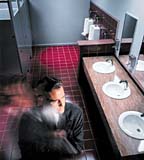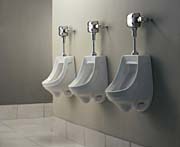It wasn't long ago that electronics in the restroom had people feeling like they were caught on "Candid Camera," quizzically approaching faucets with no handles and trying to push the infrared eyes. The long delay before activation of those first models didn't help matters either. People would pull their hands away before the faucet ever had the chance to activate!
The plumbing industry and the public have come a long way since that first wave of electronic plumbing products. The industry has trained a confused public, educated vexed plumbers and fixed the reliability issues that once plagued electronic plumbing devices. Today, electronics have become a popular choice in public restrooms for both designers and users. When patrons see electronics in a restroom, they might get a better feeling about the building in general. A high-tech restroom gives the impression that the building is clean, efficient and modern.
The specification of electronic faucets has grown from a few, select, high-end installations to the mainstream of plumbing design. Some of the applications for electronic plumbing products include many institutions where hygiene is an overriding concern. These include hospitals, laboratories and the food service industry. Other institutions with high usage, such as schools, airports and stadiums, turn to electronic plumbing products both for their hygienic and their water saving features.
While the demand for electronic plumbing products has risen steadily, the decision for buyers and specifiers has become more complicated. There's a variety of electronic plumbing products on the market to choose from, each with its own set of features and benefits. Not only is it important to understand when using electronic products is appropriate, but knowing how to choose among them is crucial as well. Understanding the trade-offs and weighing the value of the features available on electronic faucets and flush valves has made the selection process more difficult. This article will discuss the issues of when and how to select electronic plumbing products and help to make the choice a little bit easier.

Hygiene
The increased hygiene associated with the use of electronic plumbing devices is an important reason for their popularity. Parents often caution their children, "Don't touch that, you don't know where it's been." Well, in a public restroom, you do know where it's been. People, in general, are worried about the health risks of using public restrooms. Every time the handle of a flush valve or faucet is touched there is a residue of germs left behind that may be transferred to the next user. Since electronic plumbing products don't require touching, they can minimize the spread of germs and disease in restrooms and thereby alleviate public fears.
Another hygiene-related issue in public restrooms is odor. When urinals and toilets are not promptly flushed, the unpleasant lingering smell can give the impression of a poorly maintained facility. Electronic flush valves can reduce restroom odor significantly by automatically flushing urinals and toilets after use.
Water Conservation
In the past few years, water conservation has become increasingly important. Water is starting to be recognized as a limited resource and to be treated as such. Local governments all across the country have put regulations in place to curb water usage. Choosing to specify a low flow electronic faucet can be an effective way to meet water conservation regulations. A single faucet, with a 2.0 gpm aerator, left running for one hour would waste 120 gallons of water. Electronic faucets automatically shut off when not in use, preventing the water from being left running either accidentally or intentionally. This feature alone saves quite a bit of water.Electronic faucets can also limit the amount of water per use. When choosing an electronic faucet, specifiers should consider finding one with a variety of flow timing options. Most electronic faucets are programmed to turn on with infrared activation and turn off automatically after hands have been removed. Some high-tech models also give the owner the option of a number of special settings, including a water conservation mode. In water conservation mode, water flows for only a short period of time after initial activation, usually about 5 seconds. The water savings represented by shutting the water off a few seconds earlier per use could be significant in a high volume restroom. Other special flow time settings can include metering mode and scrub mode. In metering mode, the electronic faucet works just like a mechanical metering faucet, with timing that can be set to a site's specific needs. Scrub mode allows the faucet to run for an extended period of time (up to 180 seconds) with a single activation. The availability of this type of option is especially important for hospital situations where doctors need extra time to wash.
Water conservation, while still important, usually plays less of a role in the choice of electronic flush valves. Hygiene takes precedence over water conservation when it comes to flushing, and electronic flush valves ensure a flush after each use. However, there are a number of ways that electronic flush valves can be useful for water conservation as well. First, electronic flush valves prevent double or triple flushing at urinals by allowing only a single flush after use. Second, similar to the more high-tech electronic faucets, some electronic flush valves allow the owner to fine-tune the volume of water used per flush. Many urinal fixtures are rated to work at .7 gallons per flush (gpf), while most electronic and manual flush valves only have a 1 gpf setting. Finding an electronic flush valve that can be set to match the fixture rating can have a significant effect on water savings, especially in a restroom with high traffic.
Americans with Disabilities Act
The Americans with Disabilities Act (ADA) has had a profound effect on how plumbing products are specified. Because of their strict adherence to ADA requirements, electronic plumbing products can offer an advantage in these applications. Through the use of infrared sensors to ensure activation, electronic faucets and flush valves do not require the manipulation of handles, which can be difficult for some disabled people. As a result, electronic products can provide comfort and convenience for the disabled.
Vandalism
Preventing vandalism is an important consideration when specifying plumbing products for public restrooms. This is especially true when dealing with high usage restrooms, like those in schools and airports. Why certain individuals go to great lengths to destroy public property, and restrooms in particular, is a matter for debate. The fact that this does happen, however, is not. The evidence is clear; plumbing products must be prepared for abuse. Electronic faucets and flush valves have some key areas of vulnerability that should be carefully considered. In a robust electronic design, the exposed portion of the infrared sensing eyes will be minimized. This will prevent the possibility of damage from people jabbing or pushing on them. Shielding the electronic eyes will also discourage people from trying to melt them with a match. (Yes, it happens.) Be sure to look carefully for any exposed electronics or loose wires. External wires should be encased in metal sheathing to protect them from being cut, and electrical boxes should be securely sealed and mounted to the wall. Above-deck electronic faucets effectively deter would-be vandals by concealing all of the electronics in the faucet body. Additionally, for all faucets being used in public spaces, look for vandal-resistant aerators and screws.Maintenance
An important maintenance feature to look for in electronic plumbing products is the ease of changing batteries. With some electronic flush valves, new batteries can only be installed after the maintenance crews have shut the water off. Look for models on the market that use a separate compartment for the batteries and don't require water shut-off for battery replacement.
The use of electronic plumbing products can also significantly reduce the degree of effort necessary to maintain a public washroom. There tends to be less wet mess on the sink deck with electronic faucets because there are no dripping, soapy hands fiddling with handles. Electronic flush valves keep the toilet and urinal fixtures clean because they are always flushed after use.
Ease of Installation
Although the plumbing industry has come a long way in educating plumbers about electronic products, installation can still be an issue. Each electronic faucet or flush valve has its own unique installation procedure. When it comes to installation, the easier, the better. Often the reliability issues that surface for electronics down the road can be traced back, at least in part, to the installation. The good news is that many electronics product manufacturers have significantly simplified the installation procedure. Look for products that require the fewest number of procedures outside of the scope of the average mechanical installation. Battery-operated faucets with all of their electronics above deck are often the easiest for plumbers to install because installation is very similar to a mechanical faucet.Aesthetic Design
A non-functional, yet important, consideration in deciding among electrical plumbing products is aesthetic design. In the past, there were few design alternatives when it came to electronics. And while that is still basically true of electronic flush valves, electronic faucets are now available in a variety of design options. Architects can choose from traditional lavatory spouts to elegant gooseneck spouts to above-deck European styling.A Word of Caution
All electronic plumbing products do not function equally well in every environment, and there are some situations where electronics may not be appropriate. Exposure to electromagnetic radiation is one environmental factor that has been known to cause electronics to malfunction. The presence of electromagnetic waves can interfere with the infrared technology used for activation. Emitters of electromagnetic radiation include power stations, television/radio transmission facilities, x-ray equipment and dialysis machines.Environments subject to extreme heat and high humidity are also particularly hard on electronic plumbing products. Elevated temperatures can have the effect of decreasing battery life. Excessively humid facilities or ones that use high-pressure spray for cleaning threaten the reliability of many electronic plumbing products.
Consult with the product manufacturer before specifying electronics in these harsh environments.
Conclusion
As discussed above, there are many good reasons to select electronic plumbing products for use in public restrooms. Currently available electronics provide increased hygiene, water conservation, ease of use and simple maintenance. However, the future of electronic plumbing devices is sure to include many innovative surprises. Voice activation for plumbing products is one technology that is likely to gain more attention in the near future. Another is the use of wireless technology to collect and analyze maintenance needs. This could be especially attractive to large facilities, where many restrooms must be monitored by the maintenance staff. Other seemingly futuristic technologies are available today. Some electronic products can communicate with handheld devices to provide feedback to their owners about usage, battery drain and other maintenance issues.Whatever the future may have in store for plumbing products, one thing is certain. Choosing among all the different options is likely to get even more difficult. Yet, no matter how high-tech the plumbing industry becomes, you can be sure that when it comes to choosing electronic products, good old common sense will always rule.